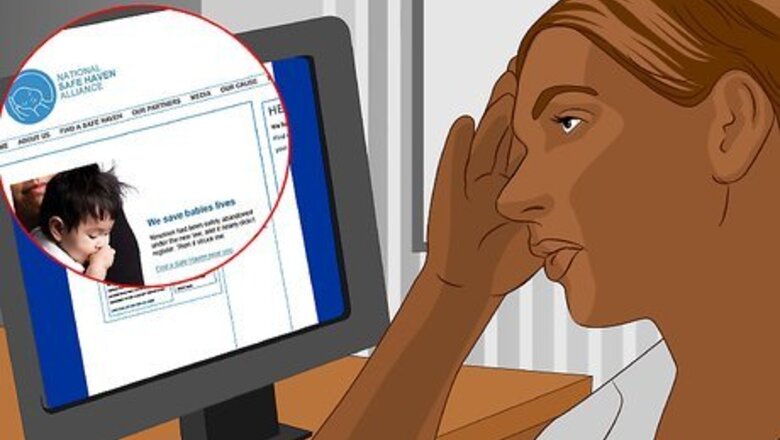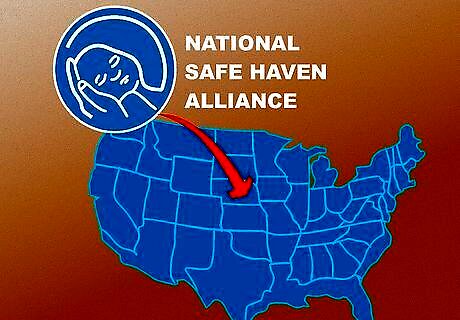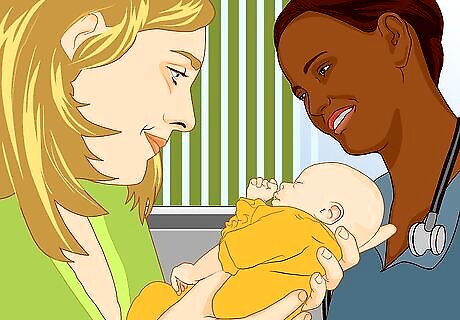
views
X
Trustworthy Source
Child Welfare Information Gateway
Online portal managed by the U.S. Children's Bureau providing resources related to childcare and abuse prevention
Go to source
There are also ways to reunite parents and babies if this is desired. If your state does not have a safe haven law, or if your child is too old to qualify, you might choose to put your child up for adoption. If you are a mother (or other individual) who needs help in doing what is right for your baby, here are some steps and resources.
Finding the Closest Safe Haven Locations

Get help from online sources. If you have a newborn baby but cannot care for it, many resources are available to help. Look up the Safe Haven laws in your state and find out what you can do. The laws will protect the baby and also protect the mother and/or father’s anonymity. However, remain anonymous, the law must be followed carefully. These sources make it easy to link directly to your state and find out the requirements. National Safe Haven Alliance – http://www.nationalsafehavenalliance.org/ Child Welfare Information Gateway – https://www.childwelfare.gov/topics/systemwide/laws-policies/state/?hasBeenRedirected=1 Baby Safe Haven – http://safehaven.tv/about.php U.S. Legal link to Safe Haven Laws – http://safehavenlaws.uslegal.com/

Talk to an attorney or social worker, if possible. These Safe Haven laws exist to ensure the safety of the newborn baby and make it possible for desperate people to relinquish custody without resorting to extremes. They are not created as ways to get troubled parents in more trouble. If you find yourself in this situation, you should feel safe to reach out to an attorney, a social worker, or even a member of the clergy. In all these cases, you would be protected by a privacy privilege in what you say to them, and they should be able to help you get connected with a Safe Haven location.

Call ahead for details. Call your local hospital, police station, fire station, or other location that you believe may be a Safe Haven site. Ask the person who answers if they do accept drop-offs, if they have certain times, and if they have certain requirements. If you are concerned for your anonymity on the phone, you can dial #67 before calling to block your number from appearing.
Deciding Who Will Drop Off the Baby, and Where

Decide who will drop off the baby. In most states the mother, father, or any adult who has legal custody is allowed to drop off a baby. In four states (Georgia, Maryland, Minnesota and Tennessee), only the mother may drop off the baby. A few states allow any adult to drop off a baby, as long as the mother approves. Eight states (Delaware, Hawaii, Illinois, Maine, Nebraska, New Mexico, South Carolina and Vermont) have no law about the person who may drop off the baby.

Find a “Safe Haven.” Every state allows for an unwanted, unharmed baby to be relinquished to an employee on-duty at a licensed hospital. Beyond that, every state has a variety of safe haven locations. In order to remain anonymous, and to avoid being prosecuted for child abandonment or endangerment, you must find one of these recognized locations.

Select the location. In addition to taking the baby to a hospital or emergency room, states allow the following safe haven locations. Be sure to research your state's safe haven law so that you know which will apply to you: Police and fire stations. Most states have designated police and fire stations as safe haven locations. In states where police and fire stations have been named as safe havens, the baby must be left with an on-duty employee. Medical centers. In states where medical centers are designated safe havens, the laws are very clear; babies can be left at medical centers during business hours and only with an on-duty employee of that medical center. Churches. In states where churches are considered safe havens, the law generally requires that the baby be left inside and that an adult be present at the church at the time. Some states require the baby be handed to an employee with emergency medical training. Adoption agencies. A few states approve adoption agencies as safe haven drop offs. In those states that allow a baby to be dropped off at an adoption agency, the baby must be handed to an employee of the adoption agency during normal business hours. Welfare agencies. A few states allow licensed welfare agencies to act as safe havens. In these states, the baby must be handed to a volunteer or employee of the company during normal business hours. Other. A handful of states allow a parent to call emergency services and relinquish a baby to an Emergency Medical Technician (“EMT”) or an emergency responder, or leave the baby with an employee at a birthing center, institutional infirmary, or other medical facility.
Preparing the Baby for Drop-Off

Determine what information should accompany the baby. All states will allow the mother or person dropping the baby off to remain anonymous. But some will provide the person dropping the baby off with a questionnaire that can be dropped in any mailbox once completed. The questionnaire contains simple questions about the baby's medical history and any serious medical conditions the mother or father may have. You may also wish to consider preparing a simple document with the baby's date of birth and any serious medical conditions that run on the mother or father's side of the family to leave with the baby to ensure he or she gets proper medical care.

Prepare to drop the baby off. The safe haven laws do not generally specify any condition for the baby at the time of drop off, except that the baby must not show evidence of abuse or neglect. The list of suggestions below are some things you should do, just as general care, to prepare the baby. In some states, failure to take these basic steps could be considered "neglect" and could leave the parent open to criminal charges. Keep in mind "neglect" mean grossly inappropriate care, as authorities have no wish to persecute desperate parents trying to do the right thing. Feed the baby. Ensure that the baby has been well fed and will not need to eat again for at least a couple of hours. A just-born newborn does not have to eat immediately. Bathe the baby. Wash the baby and his or her hair thoroughly with baby soap and shampoo. Change the baby's diaper. Also, put rash cream on any rashes in the genital area or the bottom. Dress the baby appropriately. A good rule to follow is to dress the baby as you would dress. For example, if it cold outside and you are wearing long pants and a sweater, dress the baby in a long pants and a sweater. A just-born baby will likely be fine wrapped in a blanket or towel unless it is extremely cold out.

Go to a Safe Haven site. Most state laws require that you hand the unwanted baby to a responsible adult employed at the safe haven location you have chosen. To do this: Choose an adult employee or staff member. This may be a nurse at a hospital, police officer at a police station, pastor at a church, or firefighter at a fire station. Tell the adult you have chosen that the baby is unwanted and you are leaving him or her pursuant to your state’s safe haven laws. Hand over the baby and any blankets, bottles, or toys you have brought for the baby, as well as any writing you have prepared, such as the baby’s name, date of birth, or medical history, to the chosen adult, and you will be free to go.
Conducting Adoption Proceedings

Decide if adoption is right for you. Adoption is a tough process for a mother as it results in the relinquishment of your child to another family. However, in some situations, completing an adoption can allow for your child to have the best life possible. Whether your pregnancy was unplanned or you do not have the financial means to care for a baby, consider an adoption if safe haven laws do not exist in your state. If you are concerned about the cost of an adoption, most (if not all) of your costs are paid for by the adoptive parents. This includes support costs, medical costs, and legal costs.

Call an adoption professional. If you think adoption would be a good option for you, or if you have more questions, contact a professional adoption agency. These professionals will help you understand the process, make plans, and fill out the required paperwork. There are multiple professional agencies in every state. Start by doing an online search for adoption agencies in your state. In addition, you can call your state's department of children's services to get more information.

Create an adoption plan. With your adoption professional by your side, work together to make an adequate adoption plan. Your professional will explain all of your options to you. For example, you might want to ask about open and closed adoptions. In an open adoption, you will have varying degrees of access to information about your child as he or she grows up. This might include physical contact, pictures, letters, or phone calls. In a closed adoption, you will not have any access to information about your child. These decisions can be made by you alone, but it is best to discuss these options with the adoptive family you choose. Ultimately, for the adoptive family to agree to the adoption, they will have to agree to your adoption plan. If you are still pregnant, your adoption plan might include labor plans, hospital plans, and ways to get help paying for the pregnancy (if the adoptive parents are not paying). These plans may also help you find food, housing, and maternity clothes while your pregnancy is happening.

Find an adoptive family. While many parents do not like to search for adoptive families, doing so can help ensure your baby will have a happy and healthy home. When you are working with an adoption agency, talk with them about what you are looking for in an adoptive family. The adoption agency will then send you information about possible adoptive families. Look through this information to learn about their careers, interests, parenting style, and other important information. A lot of adoption agencies require the adoptive parents to go through home studies and background checks before they will be eligible to adopt. Once you decide on a family, you can choose to meet them in-person or over the phone. This will give you an opportunity to get to know the family better and make sure it is a good fit. Make sure you address any concern you have before moving forward.

Consent to the adoption in court papers. Once you agree on an adoptive family, that family will file a court action to formalize the adoption. Once the action is brought, you will be asked to sign a consent form, which indicates your willingness to go through with the adoption. Return your consent form to the adoptive parents once it has been filled out.

Go to any required court hearings. In most states, if consent has been given by the biological parents for the adoption, you will either not have to go to any court hearings. If you do, they will be very informal and the judge will simply want to make sure you know what rights you are giving up. Go to your court hearings, if you have any, and be prepared to express your willingness to go through with the adoption.

Sign relinquishment papers. Relinquishment papers finalize the adoption and relinquish most, if not all, of your parental rights to the adoptive parents. Adoption agencies often provide services for mothers after relinquishment papers have been signed. Because giving your child up for adoption can be tough, adoption agencies will often offer emotional support and classes to help you cope with your decision. Some agencies will help you get in contact with other mothers who have gone through adoptions themselves. Use these resources to help you get through the emotions of putting your child up for adoption. It is important to note that once you relinquish your parental rights means to permanently lose all rights to the child. If your child's other parent wants to maintain their parental rights, the state may give them full custody but it can be more difficult for you to terminate your rights as the judge may order you to pay child support if they deem it to be in the best interests of the child.




















Comments
0 comment